“Landed!” I texted my friend, using the airport wifi. “Where you at?”
I had just stepped off plane and into Dublin Airport, Terminal 1. My friend from home, Durso, had also just arrived—from Scotland.
This trip was months in the making. During the summer of 2017, Durso had asked me if I would like to meet up with him in Dublin for a weekend. Well, he didn’t just ask; he gave me an offer that I could hardly refuse: “If you come, I’ll pay for the hostel.” Free things have always been a weakness of mine; and in any case it sounded like fun, so I said: “Absolutely.”
Now it was December of that year. I hadn’t seen Durso, or anyone from home, in about three months.
In minutes I received a text from him:
“Word, just arrived. What terminal you in?”
“Uh, not sure. Lemme check… It’s terminal 1, I think.”
“OK, be right there.”
“But where are you?”
“Terminal 2.”
“I’ll head your way.”
The walk between the two terminals is short and well-marked. It would be difficult to miss somebody coming the opposite way. Nevertheless, I managed to get to the strikingly more modernistic Terminal 2 without catching sight of my friend. When I reconnected to the wifi, I messaged him.
“I’m here, Terminal 2. Where you at?”
But I could tell from the single, grey checkmark that my message didn’t arrive, which meant that he was off the wifi. I waited. The minutes passed slowly. I was a bit nervous. It’s always somewhat stressful trying to find someone without the use of phones, like people did in olden days. And I was also nervous because, though I’ve known Durso for a long time, I’ve never travelled with him. In fact, it had been about a year since I had travelled with anybody. I had gotten into the habit of solo travel after a breakup, and had gotten so used to it that I was convinced that company only made a trip worse. When I was alone I could do what I wanted, when I wanted; but now I would have to compromise. This was a test.
As I stood there, waiting for Durso in the cavernous hall of the terminal, I felt that this experiment was already failing. But soon enough, the trusty figure of Durso emerged from the crowd of travellers—unshaved, dressed in a collared shirt, a blazer, sunglasses, and brandishing his trademark curly locks.
“Bro!” he said, before we hugged.

“Hold on,” I said. “I need to take a selfie for my mom.”
That done, we made our way to the bus.
“Why are you all dressed up?” I asked him.
“Man, whenever I’m in Europe, I feel like I’m so badly dressed, so like everyday I get dressier and dressier. I just feel so ashamed around Europeans.”
“Weird. Well how’s your trip been so far?”
“Oh, dude, it’s been awesome.”
And at this, Durso launched into an impassioned and somewhat rambling account of his previous travels. His younger brother, Zach (whom we were to meet in the center), was studying abroad in Galway, and so Durso’s family took a trip to meet him there. Then, Durso had taken his own trip to Edinburgh and Glasgow (he liked the first and hated the second).
“Dude, so I went on this awesome walk in the highlands, after I took a bus to get there. And I was just walking and walking and it was, like, just so beautiful. But it was also really cold and I totally didn’t dress for it, and there were no people around, and I was just walking and walking, and finally the sun started setting, and I was like ‘Oh my god, I’m lost, I’m lost, I’m totally going to die, I’m going to get lost and freeze to death,’ but in the end it was fine, I just found the bus and went back to the city.”
Durso also had very positive impressions of Galway, which he vastly preferred to Dublin.
“Yeah, so, like Dublin is a nice city, but you don’t get a real feel for Ireland there. In Galway there were all these little boats and fishers and stuff, and the countryside was just so nice, so nice. Man I can’t wait to go back.”
The bus (the Airlink 747, a double-decker) wound its way to the city center, and soon Dublin came into view
I had done absolutely no research beforehand, so my only expectations were shaped by my readings of James Joyce. Needless to say, however, Ulysses did not exactly give me an accurate impression of the city. Like many old but economically successful European cities, Dublin is an arresting mixture of old and somewhat dour heaps of stone, and new and shiny towers of twisting glass and metal. And as with many an old city, it is centered upon a river—in this case, the Liffey.
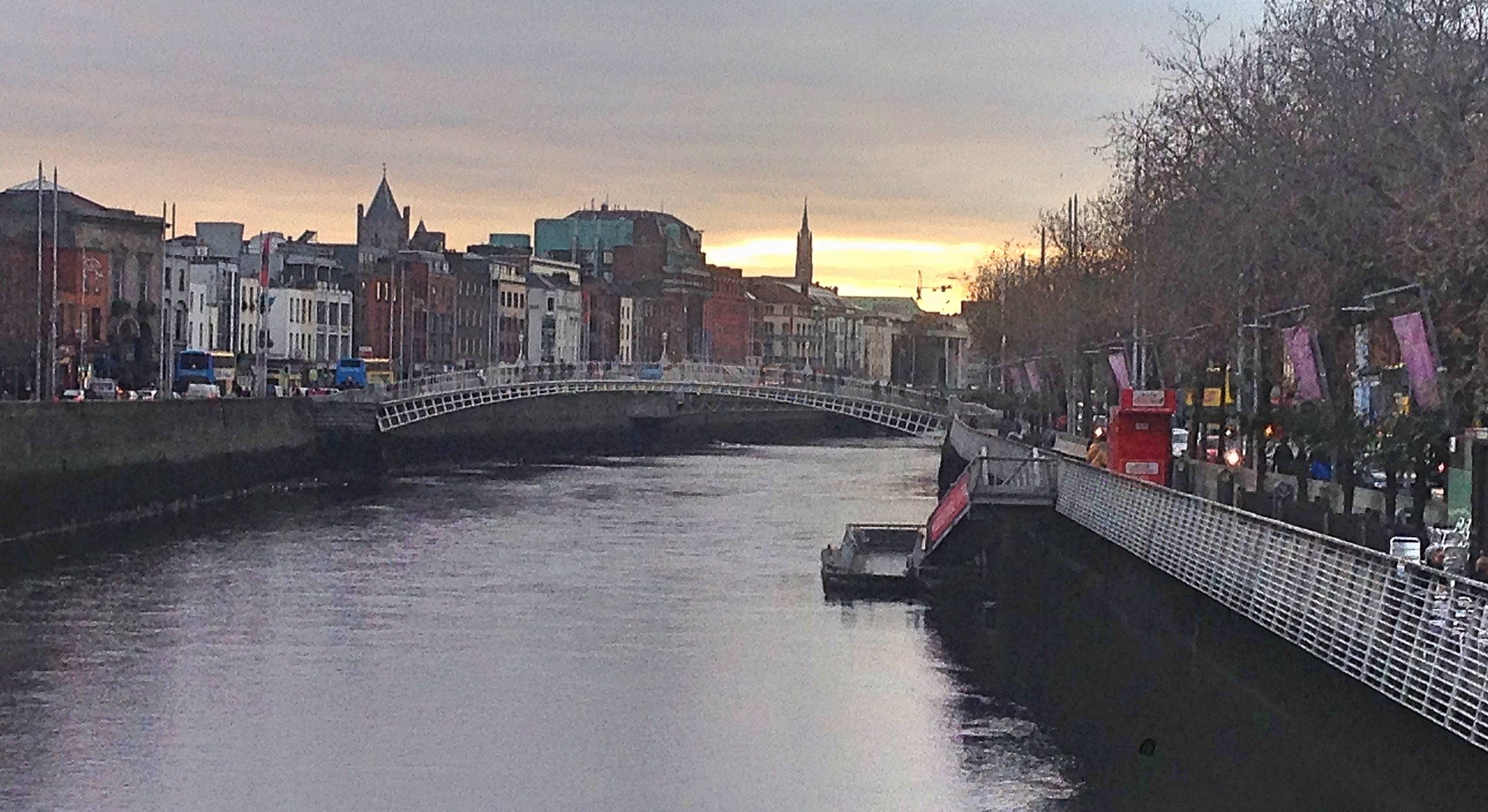
The bus deposited us right on the riverside, very near to the hostel that Durso had booked. Zach was there, waiting near a Dunkin Donuts (if memory serves). Though I had known Durso for years, and had been to his house several times, this was the first time I had ever really spoken to Zach. In high school, I passed Zach nearly every day on my walk home, as he rode his scooter in front of his house (he’s several years younger than I am). Sometimes I said “hi,” but that’s about it.
Now he was full grown—an athletic build, square jawline—and stylistically worlds away from Durso: pragmatic and understated clothes, close-cropped hair, clean-shaven. And here he was in Ireland, studying something practical like business or economics. Unlike Durso or I, this boy was going places.
We checked in to the hostel. Durso had splurged, and had booked a room right in the center of the city. When I heard the price, I nearly choked. Immediately I felt very guilty for not paying (but not, of course, guilty enough to offer to pay a part of it). It was three of us in a room with three massive, three-story bunk beds—room for nine.
“Oh man, I wonder if anyone else is gonna come,” Durso said.
“Hope not.”
We left to see the city. It quickly became clear to me that Zach was not simply treating his study-abroad as an opportunity to drink Guinness. He had done his homework about his host country, and was brimming with historical facts that he led drop as we walked. Since I was (and remain) shamefully ignorant of Irish history, many of Zach’s facts were wasted on me. But some managed to stick.
“See that?” he said, pointing to a big neoclassical building with columns in front. “That’s the General Post Office. During the Easter Rising, the rebels used that building as a headquarters, so it got bombarded by the British. Here, you can still see the bullet marks.”
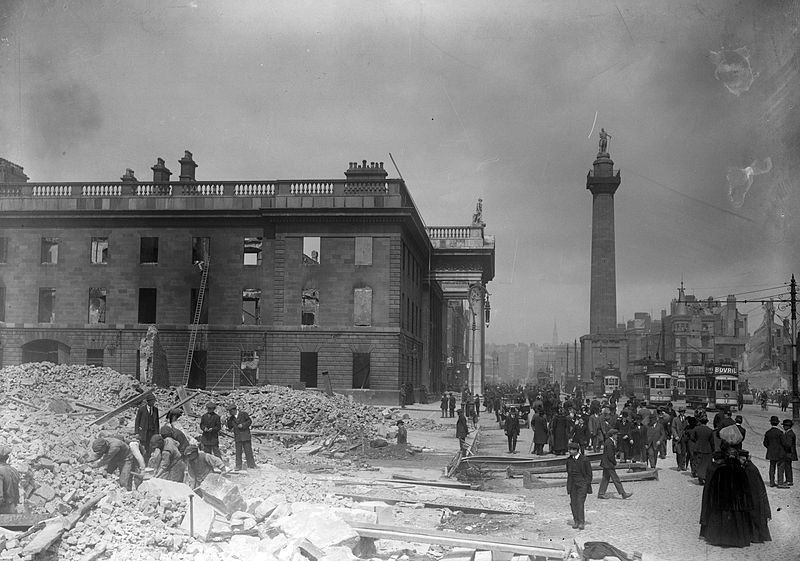
He pointed to a column and, indeed, the battle scars were unmistakable.
Next we crossed the river Liffey on the famous Ha’Penny Bridge—a very pretty cast-iron bridge, and named for the toll that pedestrians originally had to pay. Nowadays, thankfully, there are no turnstiles.

Our first stop was Trinity College, partly because I had insisted on seeing the Book of Kells. Trinity College is the oldest and most prestigious university in Ireland, and its campus has the distinguished look of academic pedigree. Stately buildings enclose a central square, through which students scurry from class to class like so many industrious ants. The Book of Kells is held in the college library. After a short queue (and about 15€) we were inside.
Well, not all of us. Since Zach had already paid to see it, he preferred to wait outside. Durso and I promptly found ourselves in a room full of backlit displays, explaining the history of illuminated manuscripts in Ireland. I wanted to take some photos for my records, but the staff were very insistent that no photos were allowed.
In his classic documentary, Civilisation, the art historian Kenneth Clarke describes the monasteries in Ireland as one of the last holdouts of Western civilization after the collapse of the Roman Empire—when Germany, France, Spain, and Italy were overrun by various “barbarian” populations. Clarke’s view is doubtless an exaggeration; civilization never stopped. Nevertheless, it is impossible to witness the high artistry and craftsmanship of these illuminated manuscripts without a feeling of awe. The Book of Kells was not the creation of a mighty artistic tradition in its prime, but was the work of a few monks on a far-off island during one of Europe’s lowest moments. As a case in point, the book was once stolen by Vikings during a raid.
I am getting ahead of myself. The Book of Kells is a sumptuously decorated collection of the gospels. As with many books during that time—all handmade and mostly religious—the book was decorated with images and patterns. The Book of Kells is special in that it is, perhaps, the most beautifully illuminated book in existence. What first strikes the viewer is the level of detail. The twisting, shifting shapes seem to curl endlessly around themselves into progressively finer and finer scales; it boggles the mind how anyone could have planned and executed such a thing. Kenneth Clarke reminds us that, in those days, they didn’t have television, so fancy patterns were likely the only visual entertainment available.

“Hey guys,” a voice behind us said.
I turned around to find—Zach.
“You came in after all?”
“I just snuck in through the exit. I remembered where it was from the last time. Nobody stopped me.”
“What a badass.”
We proceeded from the informational exhibit to the book itself. It is displayed in a darkened room (for preservation purposes, I gather) and shown beside other exemplary illuminated manuscripts. The 340 pages of the Book of Kells are bound in four volumes, and two of these are displayed at any one time, turned to different pages.
I peered down at the glass display case with reverence. I remembered first seeing the beautiful book in my Introduction to Art History class in college (taken as a core requirement), and being deeply impressed. Now I could see the masterpiece in person. The only problem was the other people. Specifically, one guy was bent down very close to the glass, and refused to budge. He stayed looking at the page for ten minutes, as the people around him jostled for space around the edges. I fully understand why the man would want to make the best of what may be his only opportunity to closely examine the glorious book. I’d love to do the same. Still, blocking other people’s views did violate Kant’s categorical imperative.
Considering the crowd and the dim lighting, you can probably get a better view of the book by simply going to Trinity College Library’s website, where the entire book has been digitized in high quality. But at least I get to brag about seeing it in person.

The last part of the visit is to the library’s famous Long Room. As one would expect, this is a very long room filled with very old books. Two floors rise upward to meet in the circular vaulted ceiling, creating a kind of tunnel of knowledge. Marble busts of great intellectuals line the lower walkway, including one of the great Irish writer, Jonathan Swift. It is a veritable temple of learning, as a library should be. And there was one more item on display: Brian Boru’s Harp.

“So this harp is supposed to be the oldest harp in the world,” Zach said. “It was made in the… 15h century I think? This was the model for the harp on Ireland’s coat of arms, so it’s like a national symbol.” (It’s also used in the logo for Guinness and Ryanair.)
“Nice.”
(Brian Boru, by the way, was an Irish king of the 10th century. The harp was reputed to have belonged to him, but that’s quite impossible, since it was made five hundred years after he died.)

When we re-emerged into the city I found, to my great dismay, that it was already getting dark. I checked the time on my phone.
“4:00?” I said in disbelief. “It’s getting dark at four o’clock?”
“Yep,” Zach said.
“In Madrid, the earliest it gets dark is 6:30!”
“Must be nice.”
“Where are we going?”
“Christ Church Cathedral,” Zach said. “It’s free.”
In minutes we were standing outside of a very pretty medieval church building. But when we stepped inside, we found, to our dismay, that you did have to pay.
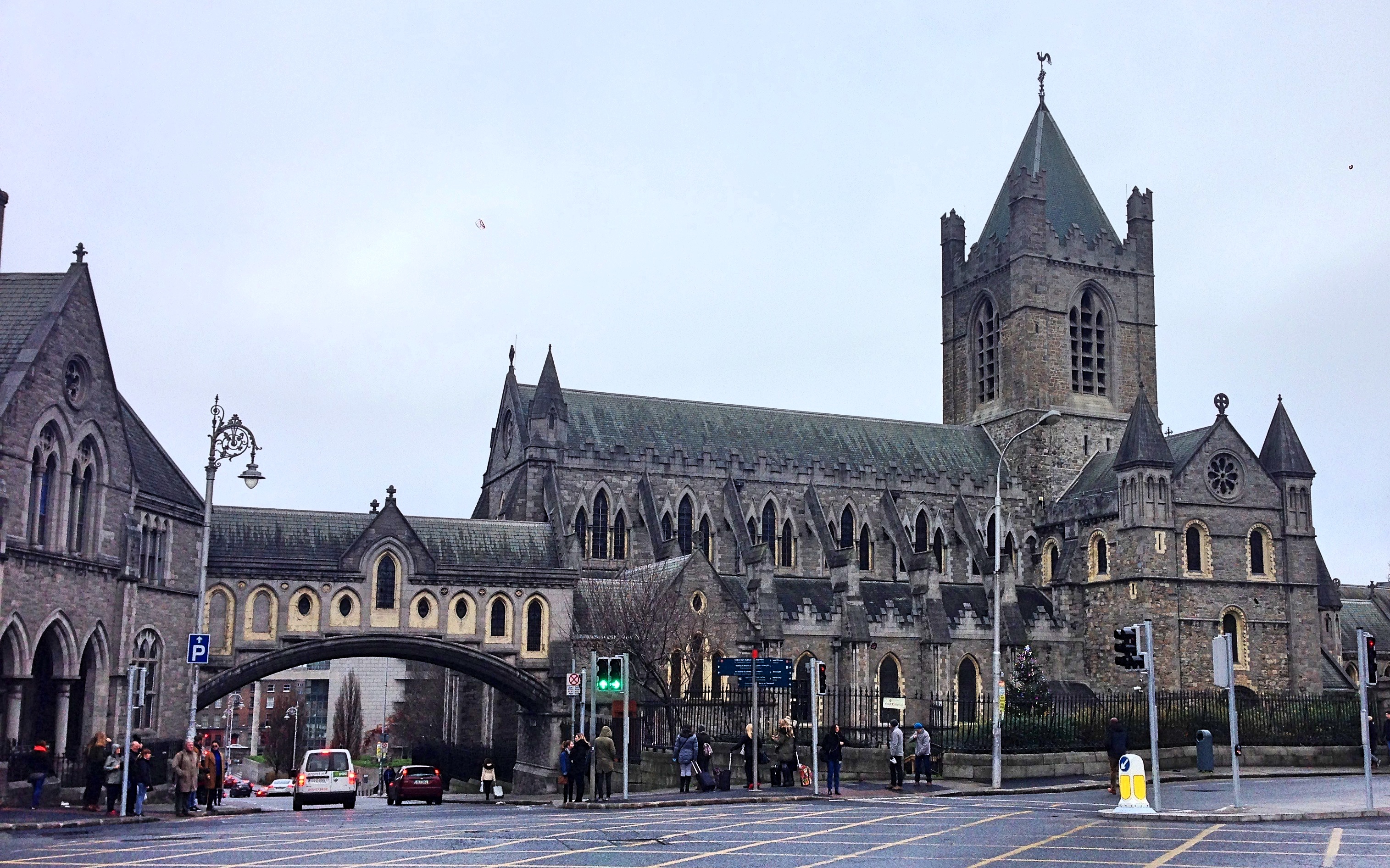
“Lame,” Durso said. “I’m not paying to get in there.”
“Me neither,” Zach said.
“Oh well,” I said. “What’s next?”
“Well, we can go see St. Patrick’s.”
This is located right down the street from Christ Church. (If you are wondering how there can be two cathedrals so close together, this is because Christ Church is the cathedral for the local diocese while St. Patricks is the so-called National Cathedral. Both belong to the Church of Ireland.) At the end of a string of red apartment buildings, the more imposing, spired form of St. Patrick’s came into view. But, unfortunately, you have to pay to enter that cathedral, too, and my companions weren’t willing—and in any case it was five minutes to closing time. If I had been alone and the cathedral had been open, I likely would have forked over the money, if only because Jonathan Swift served here as the dean.
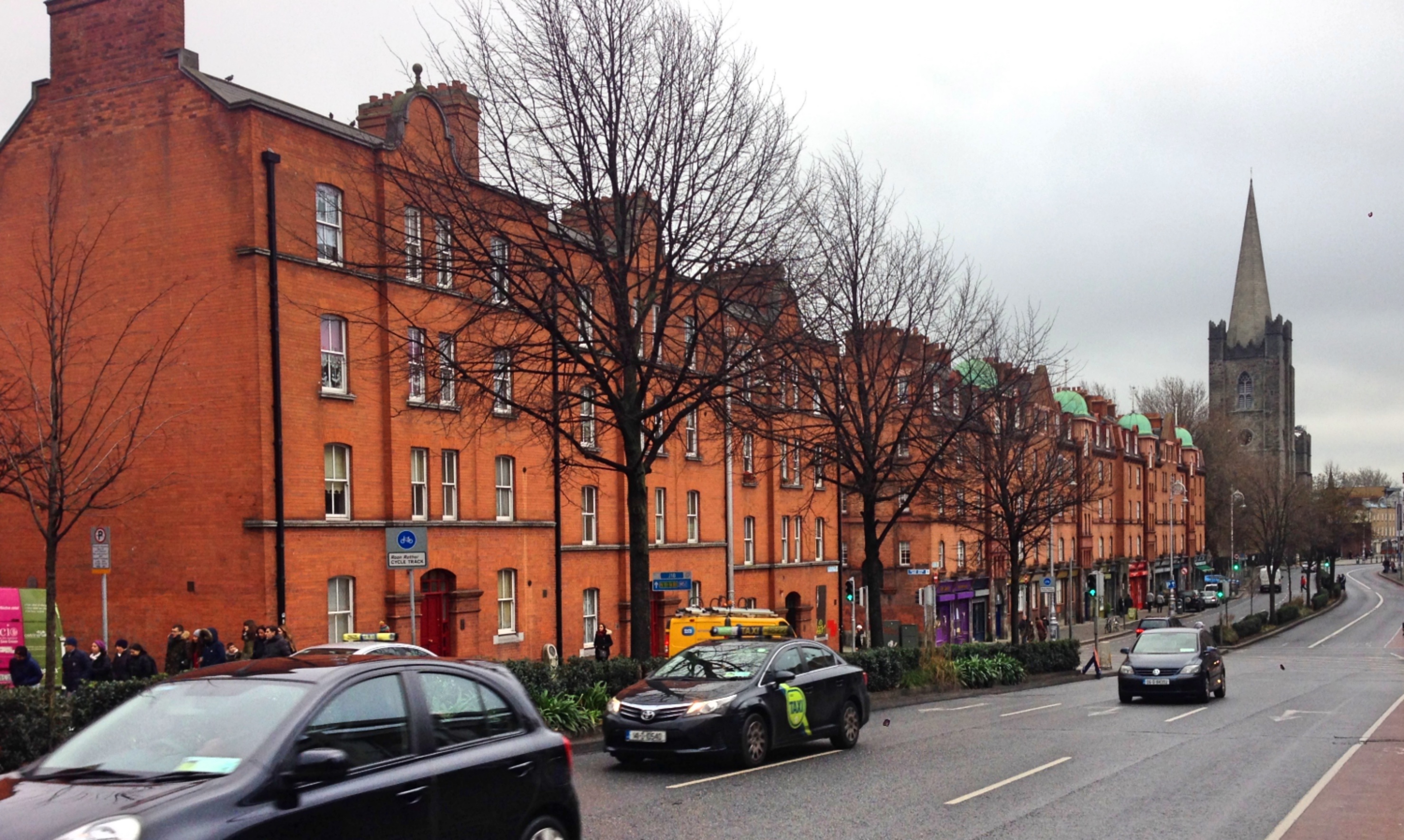
“Yeah, so apparently these two churches had kind of a rivalry for a while,” Zach explained. “Like dueling congregations. Kinda weird.”
It is indeed strange that two grandiose cathedrals for the same church would be built so very near each other. I was also surprised that there wasn’t a more imposing Catholic cathedral in the city, considering that Catholicism is the most popular religion in the country. But of course the Anglicans (of which the Church of Ireland is a branch) have historically wielded the power.
By now it was five o’clock, cold and dark, and every attraction was closed.
“What should we do?” I asked.
“Drink in the hostel?” Durso suggested.
“Sounds good to me.”
We found, to our relief, that nobody else had moved into our room when we were gone. We had the whole place to ourselves—an interior window, a concrete floor, and three triple-decker bunk beds. The beds had too little headroom to sit down in, so we sat down on the concrete floor, charging our phones. (In Ireland they use the UK-style outlets.)
Durso, as ever, came prepared. He had two bottles of liquor stowed away in his backpack, which we passed around. An hour passed this way, chit-chatting and, in my case, taking small sips (hard alcohol never sits well in my stomach), until I had a brilliant idea.
“Hey guys, let’s make fortresses. We can use the blankets from the other beds.”
Somewhat tipsy, we took the spare sheets and hung them from the upper beds, creating a kind of screen surrounding each of our bunks. I remember doing almost this very thing when I was young, pulling a bunch of chairs together in the living room and draping blankets over them to create a “fortress.” Both back then and in Dublin, it was strangely exhilarating; but why? A Freudian would say that we were recreating the elemental womb, seeking the feeling of being unborn. Well, I don’t know about that, but it did help give us some privacy in the bare room.
Now it was time to go eat. We wandered our way into the center, and wound up in a pub. It was then that I noticed how expensive Dublin is. Indeed, it is scarcely less pricey than London. But the prices seem even worse since they are in euros, making them easier to compare with the cost of Madrid.
“I can’t pay 12€ for a soup!”
“It’s good, bro,” Durso said.
I bit my tongue, since I still felt a bit guilty for not paying for the hostel.
I ordered Irish lamb stew. This is exactly what it sounds like—and it was delicious.
“I think they put Guinness in the broth,” Zach said.
I quickly finished my bowl, and mopped up the remaining broth with black bread. Scrumptious, but not nearly enough. I wanted to order more; but I had to save my money for beer.
We made our way to Temple Bar, the nightlife capital of Dublin. This is basically a zone in the center with a high concentration of attractive bars. Its name does not derive from any previous temple, but from a prominent local family or, perhaps, in imitation of a ceremonial entrance in London—scholars are not sure. The place was buzzing with activity; American accents were common in the air; and some visitors looked like they had had enough to drink already.
We went to the most famous establishment, the Temple Bar Pub (it is named after the street and not vice versa). The outside was decorated festivaly with strings of Christmas lights, and the inside was too. The place was totally packed. On the far end a group was playing traditional Irish music: a guitarist, a fiddler, and a singer. This seems to be a common staple in Irish pubs, and is very popular among the tourists. I was amazed to find that Durso and Zach knew many of the songs well enough to sing along. I was lost. Apart from movies, I had never listened to Irish music. And I must admit that, during my experience in Dublin, it all sounded very similar to me and generally failed to hold my attention.
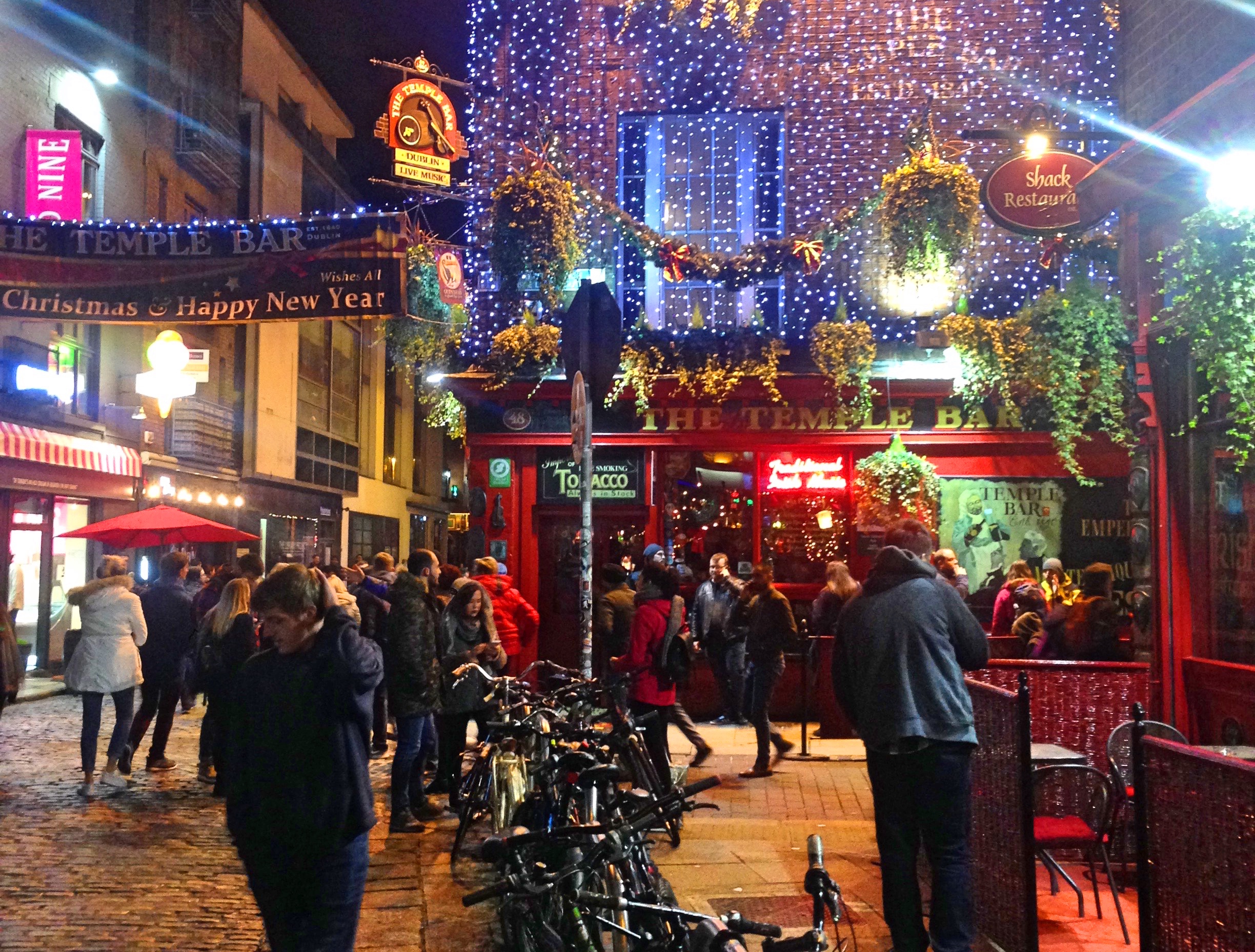
We watched a couple songs, but eventually decided that the place was too crowded to stay at. We got out into the street, braced by the relative quiet and the cool night air. It was then that I had an unpleasant realization.
“Uh, guys,” I said, tapping my body. “I think I left my bag in the restaurant.”
“Oh shit,” Durso said. “You mean your purse?”
“It’s a messenger bag.”
“Word. Was there anything important in it?”
“Not really. Just my kindle. But I’d prefer not to lose it.”
“Ok let’s go,” Zach said.
“Sorry.”
We walked back towards the restaurant. From the street, however, it was difficult to determine which one we had been in, since several nearly identical establishments were located right next to each other. After first going in the wrong one and realizing our mistake, we found our way to the right spot. There, I asked the waiter if he had seen a small brown bag.
“It looks kinda like a purse,” I explained.
“If there is any lost and found, it’ll be a couple doors down, at the hotel.”
The restaurant, you see, was affiliated with a nearby hotel. I walked inside with Zach and asked the front desk.
“A small brown bag?” he asked.
“Yeah, it’s a messenger bag.”
I waited with some slight anxiety as he went into a back room. Meanwhile, a family arrived to check in, with heavy suitcases in tow. Five minutes later, the man arrived with a familiar brown bag.
“Thanks so much,” I said, checking inside. My kindle was intact.
“Got your purse?” Durso said, as we got back to the street.
“Shut up.”
Next we went to a less crowded pub, right alongside the Liffey. It was quite a sprawling affair, with several floors and bars around every corner. Like true tourists, we ordered three Guinesses and picked a seat. On a screen they were broadcasting a performance downstairs of a man playing more Irish music.
“You know,” I said, after tasting the Guiness, “everyone says that Guinness tastes better in Dublin. But this tastes the same to me.”
“Dude, this is way better,” Durso said.
“We’d have to compare them side by side,” Zach said.
A beer and a half later, I was feeling settled in.
“You know what guys? This is awesome. I can’t believe I’m in Dublin.”
“Yeah man, this is awesome. Though Galway is a lot better.”
“Don’t rub it in.”
It was, indeed, pleasant to be in Dublin. Though we had been friends for years, I had never traveled with Durso, and had hardly spoken to his brother. I was nervous that it would be too much; that I would get sick of them, or them of me. But, in the end, it was just what I needed to feel re-connected to home.

After all, Dublin wasn’t too far off. Like New York, it was cold and rainy; and like New York, everybody spoke English. Even the people looked familiar. Durso, Zach, and I all hail from Irish stock; so walking around the streets felt like getting lost in a reunion of distant family. Most important, though, was the chance to see an old friend and to be effortlessly myself—something that is difficult when in foreign lands making new friends.
After three rounds, we left to get back to the hostel. But there was a snag.
“Hold on guys,” Durso said. “I wanna get almonds.”
We walked to a SPAR (which, if you don’t know, is a chain similar to 7-Eleven) to search for Durso’s desired snack. The store had an impressive array of nuts on sale. But no almonds.
“This is crazy,” Durso said. “Like, they have everything except almonds.”
“You sure?”
“Yeah, man, I checked everything.”
“Well, want some peanuts?”
“No, no, I want almonds.”
“But they don’t have almonds.”
“I know, I know.”
Durso searched the store with the air of a desperate man.
“Jesus, what should I get? They don’t have almonds. I don’t know.”
He held up a container of California rolls from the fridge.
“Maybe this… Do I want sushi?”
“Dude, don’t get sushi, man,” I said. “It can’t be good.”
“But they don’t have almonds.”
“Look, Durso,” Zach said. “How about this?”
And he handed Durso a pack of rice cakes.
“Hmmm,” Durso said. “Yeah, maybe, maybe this.”
We made it back to the hostel. Our room was at the end of a long hallway, whose walls were painted with cartoonish murals of famous celebrities. We passed Marilyn Monroe, Jimi Hendrix, and the Beatles. Meanwhile, Durso stayed in character.
“Help!” he said loudly. “Help me!”
“Shhhhh,” I said, as Zach laughed.
“I’m going to end it all! Death is the only way!”
Durso has a morbid sense of humor.
Back in our rooms, we had one last drink and a few rice cakes.
“Look what I nabbed,” Durso said, taking a glass out of his backpack.
“Did you take that from the bar?”
“Yep.”
“Dude!”
“What? I always take a glass.”
“You’re a kleptomaniac, bro.”
Then, we showered, brushed our teeth, and went to sleep in our little forts.
§
The next morning was grey, cloudy, and cold. We were headed to the beach.
To get there, we walked along the River Liffey on the north side. This took us through the more modern part of town—where, I suppose, many of the companies which make Dublin an economic powerhouse are located. We also passed by the Irish Emigration museum, which I would have liked to have visited if I had had more time, since at least half of my family line come from Ireland. A more gruesome site was the Famine Memorial, statues of six malnourished and spectral Irish (and an underfed dog), staring with hollow eyes to a hopeless beyond. Last we passed the impressive Samuel Beckett bridge, a cable-stayed bridge designed by Santiago Calatrava (a Spaniard) to look like a harp.
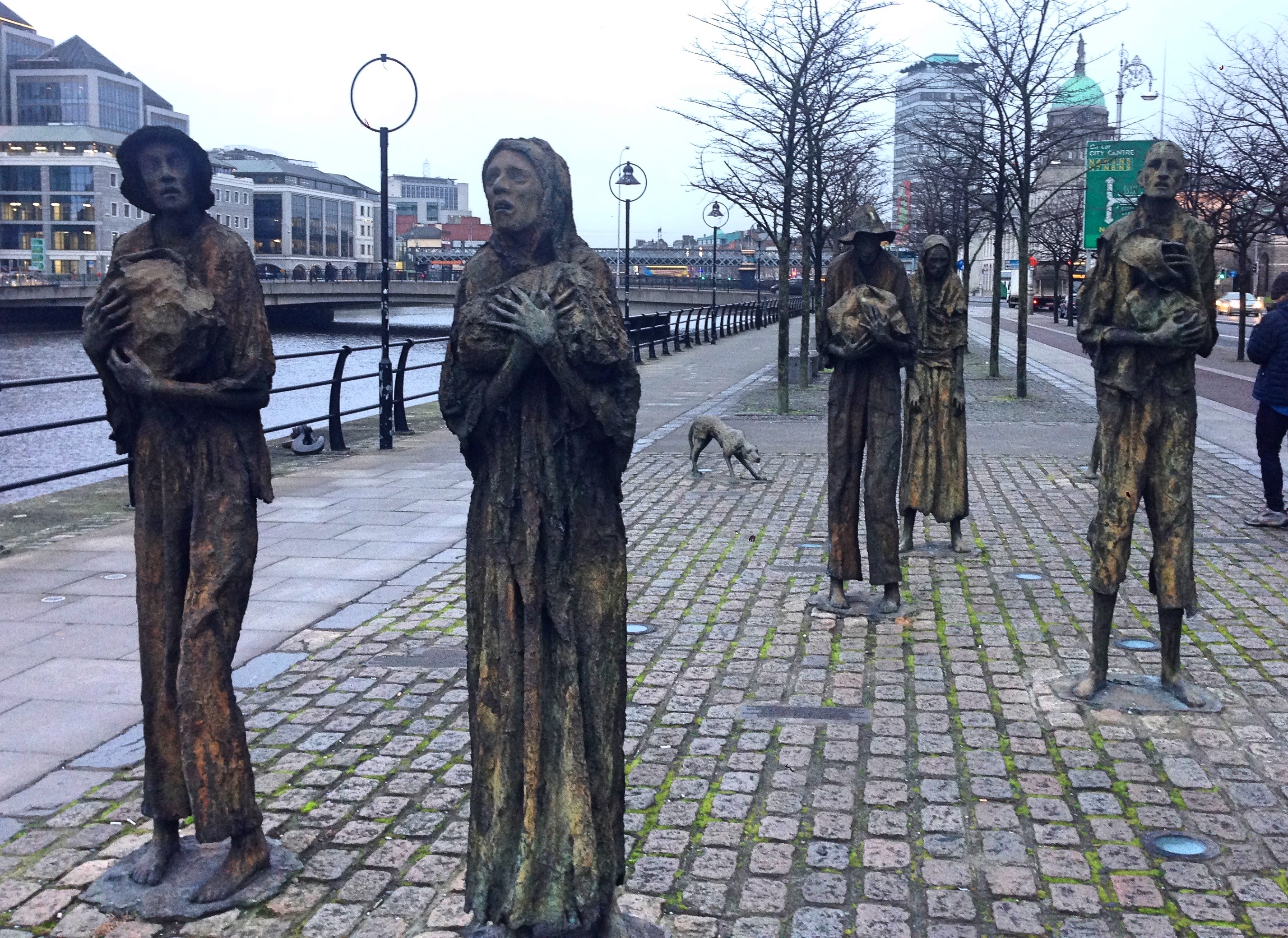
One thing which I barely noticed, but which I most certainly passed, was the Royal Canal. This is a 145 km (90 mile) stretch of water that extends from the Liffey in Dublin all the way to the River Shannon in Longford. It has long since served any serious function in transport or industry; but it has been revived as a kind of vertical park. The reason I mention this humble piece of watery infrastructure is because once, on a flight from New York to Madrid, I found a very short documentary about the canal on the plane’s entertainment system. Well, it was not exactly a documentary: two Irish Olympic athletes, mother and daughter, take a leisurely stroll along the canal while scholars and artists meet them along the way to tell them about its history. You see, I was tired but I couldn’t fall asleep; and this documentary seemed to be the most promising soporific short of chemical aid. So I turned it on and attempted, unsuccessfully, to drift off. In any case, it’s a lovely canal.

When we neared the mouth of the Liffey we crossed to the southern side and begun making our way through several attractive neighborhood blocks. Yet I am afraid that the quaintness of this part of town only called to mind Monty Python’s “Every Sperm is Sacred” (which, by the way, was not filmed in Dublin at all). Finally, after passing through a small park, we arrived at the beach: Sandymount Strand.
Well, it had sand and an ocean, so I suppose it qualifies as a beach, though I could not imagine happily wading into the water on that stretch of coastline. For one, the looming Poolbeg Generating Station—a gargantuan gas power station with two towering smokestacks—did not inspire confidence. But Durso did look great modelling on the sand.

“The snotgreen sea. The scrotumtightening sea,” I quoted. “James Joyce wrote that. The man was a genius.”
“Did he really write that?” Zach said.
“Yeah, it’s one of my favorite quotes from Ulysses. And now I finally had a chance to use it.”
My outstanding literary taste displayed, we were ready to head back into town. After another long walk (and a stop for sandwiches and coffee) we found ourselves at Dublin Castle. This is more of a government complex than a castle nowadays, although originally it did have that function. Now only one turret remains from the erstwhile medieval fortifications; it is attached to the Chapel Royal, a church used by the British leader of Ireland until the establishment of the Free State in 1922.

“There’s a river running underneath it,” Zach said. “Once on a tour they showed it to us.”
(This would be the River Poddle—which, as it happens, is the source of Dublin’s name. A stretch of the river was known as the “dark pool,” which in Irish is “dubh linn.”)
After this we took a detour through a lovely park—St. Stephen’s Green—to get to our next destination: the National Museum of Archaeology. This is part of the National Museum of Ireland; and like every branch of that institution, entry is free. Walking into a museum without a queue or a fee must be one of life’s great experiences. Other countries should take note.
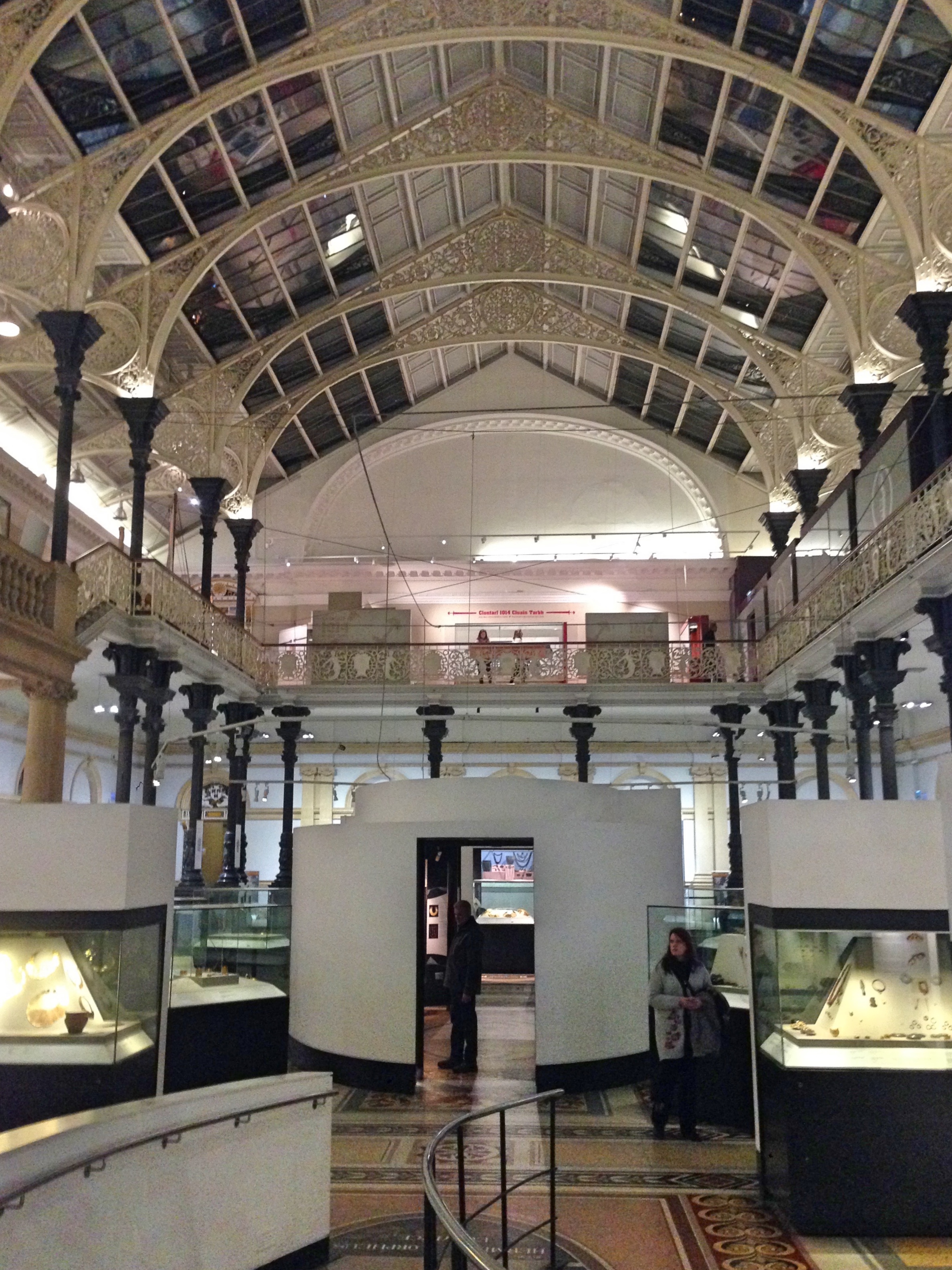
The museum is housed in a grand, cavernous structure that looks as if it used to be a train station. Its collection spans from prehistory, through the Bronze Age, to the medieval period. And there is quite a lot to see.
There was a logboat made in the early bronze age—a huge hollowed-out log that people would paddle through bogs; indeed, it is only because it got stuck in a bog that the organic material was preserved at all. In the center of the museum there is an extremely fine collection of Bronze Age gold objects. Many of these take the form of body ornaments, buttons, bracelets, or collars, and they are remarkable for the extreme skill of their craftsmanship. Collecting and shaping metal in such a way is no mean technological feat.
Aside from these highlights there were stone tools, clay pots, medieval swords, bronze axes, and information on migrations, diets, burials—the list goes on. But what interested Durso the most was the section on the Vikings. I found him near a replica Viking ship, eagerly reading a timeline.
“Why do you like the Vikings so much?” I said to him, rather rudely.
“Dude, they’re awesome.”
“No, they’re savages. They just went around raiding and raping.”
“But their lifestyle was just so amazing.”
(Durso had seen several Viking television shows.)
Probably I was too hard on the Scandinavian vandals. After all, nobody can doubt that they possessed a civilization of sorts, far outdoing their contemporaries in seafaring skill. Nevertheless, I still remain dubious of the Vikings, if only because I have imbibed the Hollywood image of them as predators on more peaceful and sedentary peoples. I am sure the historical reality is more interesting.
As Durso continued to scan the Viking timeline, I moved on, going through the Middle Ages and eventually finding myself in a small room dedicated to Egypt. Every archaeology museum must have at least a few mummies to be properly legitimate. Then, thinking that I had seen everything, I doubled back to find Durso. But he was nowhere in sight. This was odd, since from my vantage point on the second floor I could see the whole museum. As a case in point, I quickly spotted Zach, and went downstairs to meet him.
“Hey man,” I said, “do you know where your brother went?”
“No idea, I was looking for him too.”
“Alright. I think I’ve seen everything. Wanna find him?”
“Yeah, I’ll check over here.”
“Ok, he’s not upstairs, so I’ll look this way.”
And then we did what every horror movie counsels us not to do: split up to find a missing member of the party.
As I looked, I soon discovered that I had been mistaken about the dimensions of the museum. There was an entire wing that I had missed; and it was the most memorable part.
I found myself in a large space subdivided into little chambers, as in a maze; and in the center of each chamber there was a glass case containing a body. These are the famous bog bodies, corpses that have been preserved in Ireland’s peat bogs, many for over 2,000 years. The common hypothesis is that these people were ritualistically murdered, leading some to hypothesize that they were kings of a sort, since many were found near hills used to inaugurate rulers. Well, king or commoner, they are a morbidly fascinating sight. Their skin is leathery and reddish, their muscles and bones still plainly visible. Some even still have hair and clothes.
I think this was the first time in my life that I had seen a genuine corpse in person, and it was unsettling. It is impossible to examine the bodies without wondering what kind of people they were. Each was an individual, more or less like me, yet living in a radically different world and culture.
I grew so fascinated with the exhibit that I completely forgot that I was supposed to be looking for Durso. Finally I reached the end of the display room and turned around, only to bump into Durso right as I walked out.
“Hey dude, did you see those bog bodies? Totally awesome.”
“Yeah man.”
“Wait, where were you?”
“You know, just looking around.”
“Man, you’re just like my grandma, you have to read all the little signs and captions.”
“I wanna learn, bro.”
We quickly found Zach and then left the museum for our last destination: Glasnevin Cemetery. It was now well past lunch time, and the amount of available daylight was quickly running low. It was about an hour’s walk from the museum to the cemetery, most of it unremarkable, though I do remember passing over the Royal Canal.
On the way there Zach gave us another one of his fun facts:
“The Catholic church prohibited human dissections for a while, so that there was a kind of black market of human bodies. It was a big problem. Right after someone was buried, bodysnatchers would come, dig him up, and then put the body in a barrel of whiskey. This kept it well-preserved, and also it let them move the body without getting caught. Finally, they’d sell the body to whoever wanted it—like medical schools—and then they’d sell the whiskey.”
“Jesus.”
“That’s gross.”
When we arrived, Zach had many other facts to share with us.
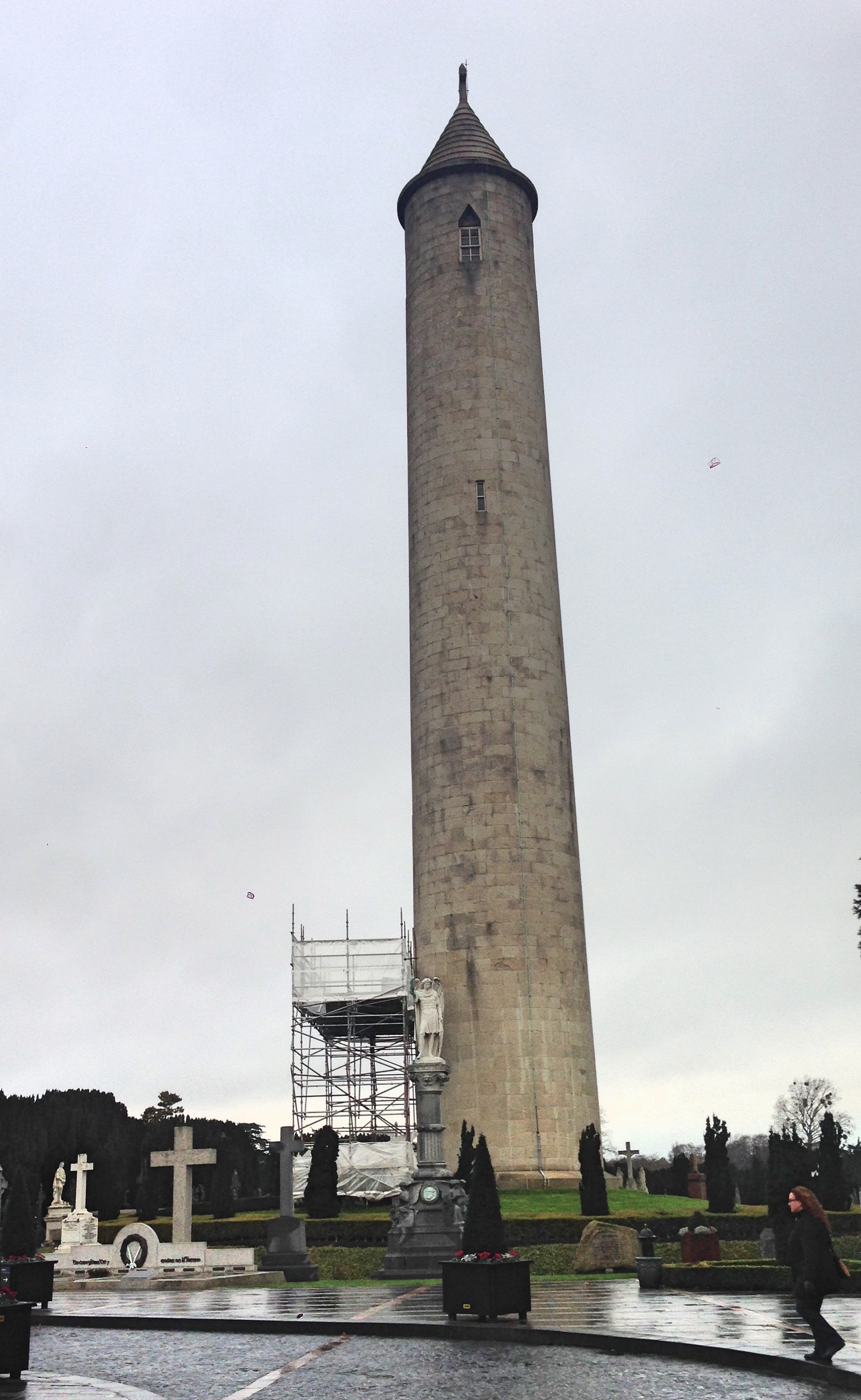
“So, for a while there was a lot of prejudice against the Catholics. This guy, Daniel O’Connell, who was a big nationalist politician, campaigned for the opening of a cemetery where Catholics could perform their rites without being bothered. That’s why he’s buried under that big tower over there.”
He pointed to the round tower, which stands near the entrance to the cemetery. O’Connell must have been quite the figure to merit such a monumental tombstone. Indeed, it would be difficult to overstate his role in Irish emancipation.
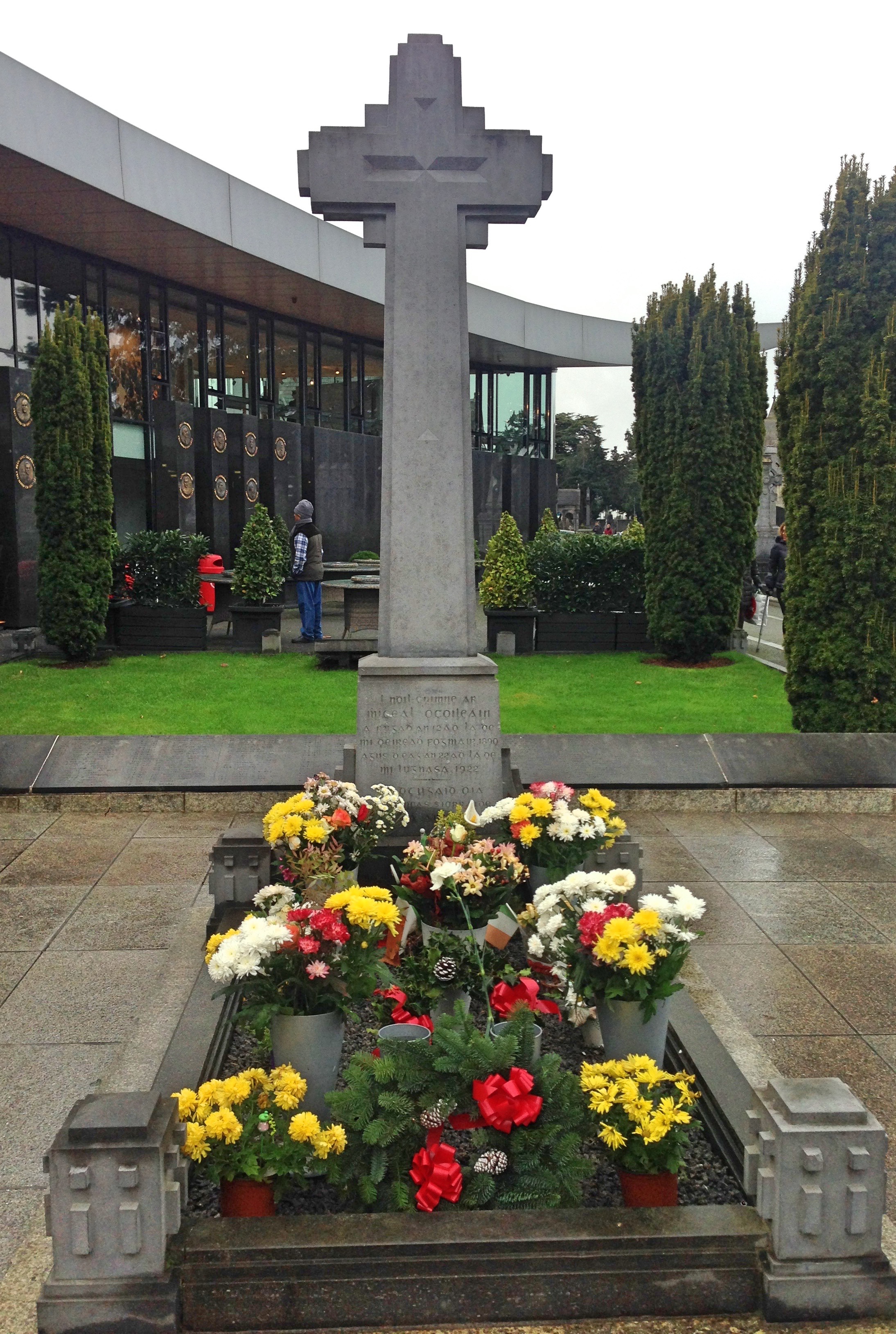
Another hero of Ireland’s fight for independence was buried near the visitor’s center: Michael Collins.
“So, this guy is a bit more controversial. He fought in the Easter Rising [which is what damaged the post office building], and then he fought in the War of Independence. Eventually the British were like, ‘OK you guys can be free, as long as you swear loyalty to the queen. Collins said that it was a good idea, since it was a step towards being totally free. But other people thought it was like giving up, and then the Irish started fighting each other, and eventually Collins got killed.”
“Jeez.”
“Yeah, but a lot of people think of him as a hero. I did a tour here, and the guide said that there’s a woman who comes once a year with, like, a ton of flowers and leaves them on the grave without saying anything. And they don’t know who she is. She’s been coming for years.”
The last national hero whose grave we visited was Charles Stewart Parnell. I already knew something about Parnell, since he is featured prominently in a Joyce short story, “Ivy Day in the Committee Room,” in which canvassers discuss Parnell’s legacy on Ivy Day, a former holiday that commemorated the politician’s death. He was noteworthy for being an Irish Protestant able to work within the parliamentary system, alongside Catholic nationalists and English Whigs, to advance Home Rule. Yet like so many politicians, his career was cut short by a scandal: in his case, an affair. Joyce, like many, believed that he could have achieved Home Rule without violence had he not been abandoned for frivolous reasons.
Yet even if you don’t know anything about the man, you can tell that he was famous just from his grave, since it reads simply: “Parnell.”

Aside from its distinguished bodies, the cemetery was lovely in itself. I am, perhaps, inordinately fond of cemeteries, since I grew up near a beautiful one; but I think nearly anyone would find Glasnevin a wonderful place to walk about in. Attractive tombstones were thickly scattered over the green lawn—crosses, busts, weeping angels. In an older section many of the tombstones had tumbled over, making the cemetery look like a ruined battlefield. Crows circled in the air above, one of them landing on a mournful statue of the Virgin Mary. Nothing could have looked more bleak under the grey December skies. Yet even in their most desolate moments, cemeteries possess an alluring tranquility: the peacefulness of our common destiny.
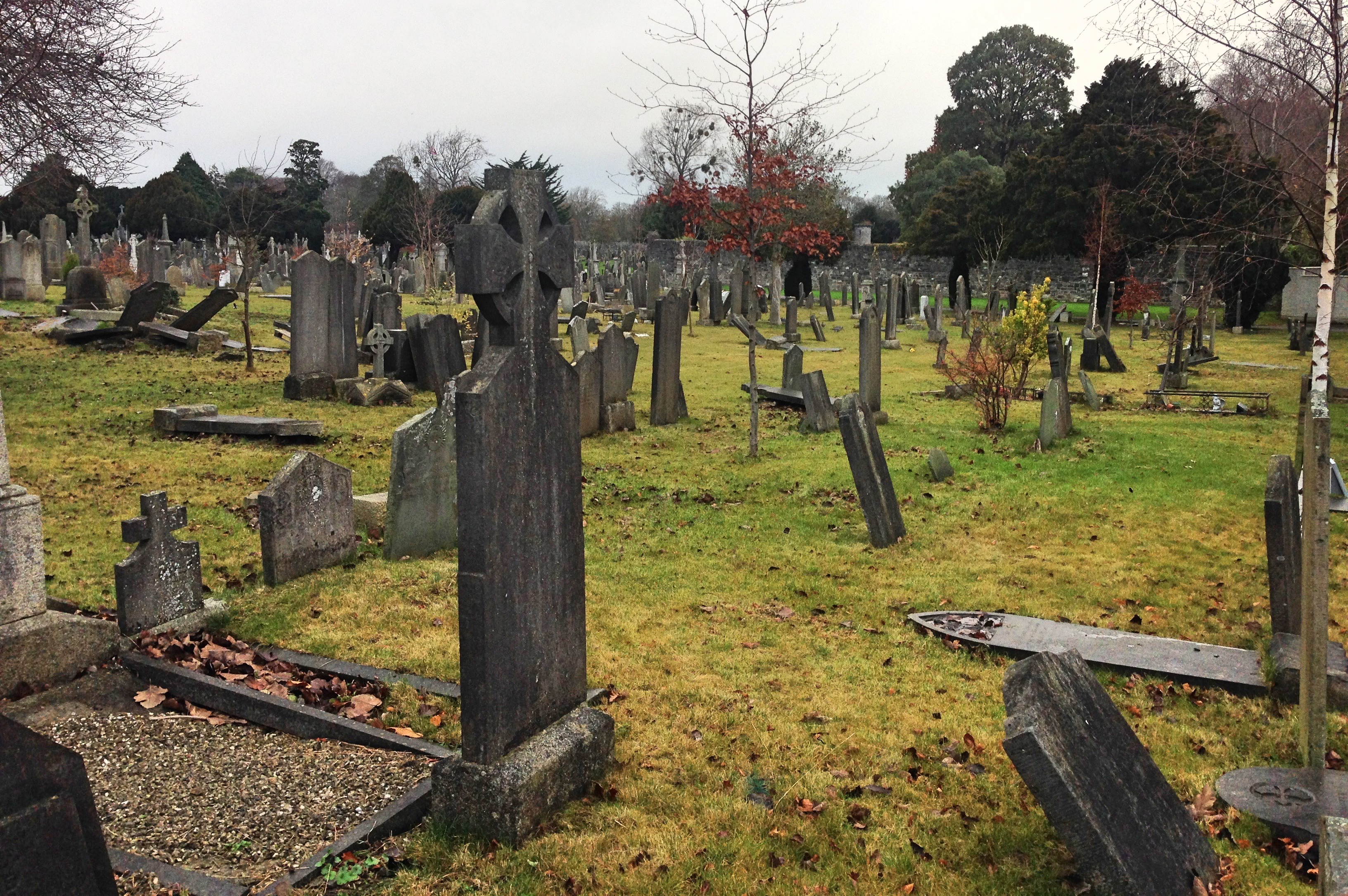
By the time we left the cemetery the sun had almost set. And by the time we made it back to the center the sky was black. As expected, we spent some more time at the hostel, drinking the remains of Durso’s liquor and wine.
“Hey guys,” I said, a few swigs in. “I’m trying to start a religion.”
“Oh yeah?”
“It’s called Lotzism.”
“Lotzism,” Zach said, “I like the name.”
“What, do we just worship you?” Durso said.
“No, no. Well, yes. But it’s more than that. The idea is for everyone in the world to slowly become me.”
“Woah.”
“The first step is to read everything on my blog. It’s the Bible of my new religion. But eventually we could use some kind of genetic technology to literally transform everybody into a clone of myself. ”
“What’s the point of that?”
“Well, then everybody would think like me and nobody would disagree with me, ever.”
“I like it,” Zach said.
“To Lotzism!” Durso said, and we toasted.
For dinner we went to what is supposedly the oldest pub in Dublin, the Brazen Head. According to its website the pub dates back to 1198, though I am somewhat skeptical. In any case, it is an attractive establishment. The seating is something of an exercise in Social Darwinism: survival of the fittest. We were lucky and found a table. I ordered bangers and mash, which seemed too English to be eating in Ireland, but it was absolutely delicious.
After that we made our way to a bar for out final collective drink. I had my flight the next day, and Durso and Zach had to return to Galway, so we couldn’t stay out very late. We found ourselves on the top floor of a rather large establishment, sipping Guinness.
“Man, I still feel so ashamed of my first night here,” Durso said. “I was in Galway with Zach and my mom and my sister and Zach’s roommate, and we went to this bar. But I just drank, like, way too much, way, way too much, and eventually people started going home, and it was just me and my sister and Zach’s roommate. And I think I went to the bathroom, or they did, but somehow I got separated. But I thought that they had, like, just abandoned me, and so I ended up walking out of the pub and into the street, but I went the completely wrong direction and I ended up getting totally lost, and eventually I just called Zach at like 3 in the morning, like so pissed, like ‘You abandoned me!’ And he was like, ‘Where are you?’ And I said, ‘I dunno, I see a McDonalds.’ And I’d gone like a long ways in the wrong direction and Zach and his roommate had to come out and find me.”
“Jesus, dude.”
“Yeah, honestly it was pretty shitty of me.”
We finished drinking and went home, but not without having a long, philosophical, and slightly bitter conversation about love. The next morning we woke up, loaded up on the hostel breakfast, and went our separate ways—Durso and Zach to Galway, me to Madrid. But all of us would meet again, soon, in New York.
